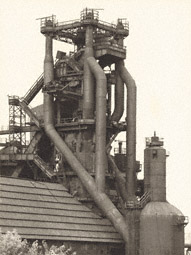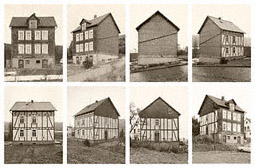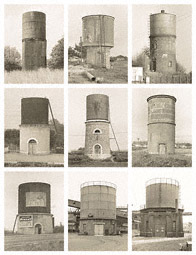|
For nearly 50 years, Bernd and Hilla Becher photographed the industrial architecture of western Europe. Using a large-format camera loaded with five-by-seven-inch sheet film, they created an archive of the basic forms that inform our understanding of the industrial era. Rendered with absolute precision in the palette of cool grays characteristic of medium-contrast gelatin silver prints, each structure is centered against a cloudless sky, filling the picture frame. Their choice to limit decisions, effectively employing a "nonstyle"—which, ironically, became an immediately recognizable style—demonstrates the role the Bechers' work has played in bridging the gap between photography as document and photography as art in the second half of the 20th century.
By organizing photographs in grid formations for exhibition or in linear sequences for publication, the Bechers demonstrated their interest in a typological exploration of form. These typologies encourage viewers to identify what remains constant in the basic form of structures that share the same function and to compare details that differ according to regional and stylistic preferences.
|
 |
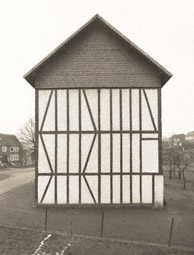
 |
 |
Framework House, Slated Gable Side, Rensdorfstrasse 1, Salchendorf, Germany, 1961
© Bernd and Hilla Becher
|
 |
 |
Bernd Becher (1931–2007) and Hilla Wobeser (born 1934) met in Düsseldorf, Germany in 1959 where both attended the Art Academy. Fascinated by the sculptural forms of the industrial structures that rose from the landscape of the nearby region of Siegen, where he grew up, Bernd soon began working with Hilla to record the typical yet "anonymous" architecture of the region's coal mines, iron ore plants, and workers' housing.
For the next four and a half decades, they collaborated on all aspects of their self-assigned project, documenting lime kilns, cooling towers, blast furnaces, winding towers, water towers, gas tanks, and other industrial structures throughout western Europe and eventually expanding the reach of their study to include Great Britain and the United States.
|
 |
|
Published in 1977, Framework Houses of the Siegen Industrial Region is the first of many monographs of the Bechers' work that focuses on a single type of structure. The half-timbered construction of these simple houses, some of which are adorned with slate shingles to protect against moisture, is characteristic of the Siegerland, a farming and mining region surrounding the town of Siegen, east of Düsseldorf.
The Bechers classified their pictures into categories of gable sides, slated gable sides, street and rear views, slated street and rear views, corner views, and groups of houses. They also included Abwicklungen, or the unfolding of individual houses in eight views to document each house in its entirety. While the Bechers' titles essentially provide the addresses of these structures, it is not necessary for the viewer to locate them geographically to appreciate unique details in relation to fundamental form.
|
 |
|
If individual images by Bernd and Hilla Becher are best characterized by the principle of objectivity, then groups of images are most readily associated with the notion of typology, or the study of types. From the beginning, the identification of types was an important aspect of their work; basic forms are a reflection of function, while details of material and style express regional preferences.
The typology occurs in two forms—in grids of identically sized photographs that encourage comparisons based on horizontal, vertical, and diagonal adjacencies (as in the typology of nine water towers depicted here), and in monographs that sequence identically printed reproductions in more traditional linear progressions. In both cases, careful looking leads to the discernment of what is essential to each functional category and to an appreciation of subtle differences within each category. The Becher's utilization of a standardized format facilitates the comparative analysis of structures that might be in the same geographic region or separated by thousands of miles, or that have outlived their usefulness and may no longer exist.
|
 |
 |
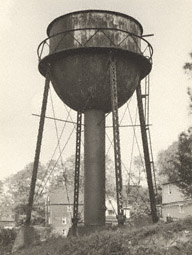
 |
 |
Water Tower, Youngstown, Ohio, United States, 1980
© Bernd and Hilla Becher
|
 |
Published in 1970, Bernd and Hilla Becher's earliest book, Anonyme Skulpturen: A Typology of Technical Constructions, set the tone for their straightforward, no-frills presentation of photographs. The book's title refers to the anonymous industrial structures that rose like sculptures from the landscape in the Siegerland, where Bernd grew up, and in the Ruhr district, where he and Hilla lived once they married in 1961. Collaborating fully on all aspects of their work, the Bechers expanded the repertory of structures they photographed throughout Germany to include Holland, Belgium, France, Luxembourg, and Great Britain. During their travels to the United States, they documented structures encountered there—coal tipples in Pennsylvania, rooftop water towers in Manhattan, and grain elevators and steel mills in the Midwest.
|
 |
